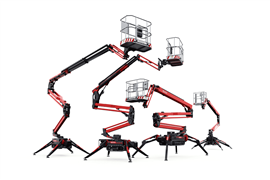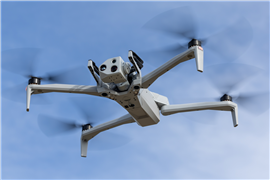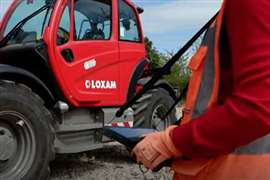Opinion: Trackunit’s Chi Sen Gay on telematics growth in Asia
09 October 2023
Technology is transforming the equipment rental industry in Asia, says Chi Sen Gay, senior vice present Asia Pacific and Japan, Trackunit. Chi Sen is one of the speakers at the upcoming International Rental Conference in Shanghai, on 23 October.
The past three-years has witnessed faster technological change in the off-highway construction rental market than the previous twenty-years.
The Covid pandemic lockdowns and the legacy of supply-chain disruption, incentivised a massive growth in telematic capabilities. OEM and third-party systems and service providers have led the digital transformation and developed a market where rental companies of all sizes can track and trace every machine they own, in their stock yards or on customer jobsites across our diverse region.
 Chi Sen Gay, senior vice president Asia Pacific and Japan, Trackunit. (Photo: Trackunit)
Chi Sen Gay, senior vice president Asia Pacific and Japan, Trackunit. (Photo: Trackunit)
According to a recent study by Report Ocean - Asia Pacific Off-Highway Vehicle (OHV) Telematics Market - the market will grow by 13.1% annually, to reach $6 billion by 2030. From OEM/dealer installed systems to after-market installers, telematics has removed the error-prone spreadsheet, fleet logs and tables and replaced them with a highly productive and tuneable digital solution.
Today, rental companies have the capability to gather and store data, as well as analyse and gain insights to optimize their fleets. Industry standards and open data protocols allow rental companies the ability to share specific datasets with customers, allowing them to right-size their rental programs and minimising equipment downtime on jobsites.
With the Asia Pacific construction market set to be the fastest growing in the world through to 2037 – construction in emerging Asia is forecast to have a compound annual growth rate of almost 3.5% according to Oxford Economics – the growth opportunity for rental companies is expanding.
Telematics is providing the platform to fully understand whole fleet utilisation and data dive on specific machine categories, customers, or even individual machines to discover, for example, out-of-contract use that could result in increased wear and tear leading to increased servicing and cost.
Tipping point for telematics
Covid was a tipping point in the acceptance of telematics across construction and rental markets, and the level of investment has increased year-on-year. Another legacy of Covid is the region’s continuing supply-chain disruption.
In discussions with rental companies, I often hear that prior to the pandemic, our region was a major market for US and European construction equipment sales. However, when lead times, during Covid, were often over 12-months, this opened the market to the emergence of Chinese OEMs. Today, the US and European OEMs lead times have improved, although the increasing quality and Chinese-business expansion across the region, ensures a highly competitive marketplace which has helped maintain, strengthen and accelerate the growth of construction.
Register here for the IRC conference, Shanghai
Construction is an increasingly complex market, and therefore rental companies are among the leaders in adopting and developing disruptive market strategies. These can offer contractors and operators more insights in their OHV usage providing the platform to increase fleet utilisation. Demonstrating data-driven approaches to fleet use can create savings in on-site fleet contracts, which translate directly to the site’s profitability.
Digital Twin is a term more associated with buildings and sites, although OEMs, rental firms and customers now view this as an important development in equipment ownership and use. An OEM-created Digital Twin provides a non-physical replica of the machine we can stand in front of and touch and feel. The sensors on the machine provide the data stream that when collected and analysed reveal whether it is operating in a fully functional manner and can highlight any variances from the pre-configured twin, ensuring machines are fit for use.
Regional governments, as well as private investors, have stimulated growth in infrastructure and private projects, while public awareness has brought climate policies to the fore. As sustainability has become increasing important as a KPI, most corporations – contractors, rental firms and OEMs – are adding this to their market plans.
CO2 emission tracking
Construction projects are increasingly targeted to collect and report CO2 emissions across the entire project site. Therefore, all machines that generate CO2 emissions must be reported and tracked. This reporting is progressing from low quality estimates to more recent data-led analysis of actual use, such as Trackunit’s Emission Reporting capability.
CO2 emissions reporting is essential and for many government and private projects it has become a condition of the contract. Rental companies are looking at this as an opportunity, offering customers value added services which could generate additional value and revenue.
Asia Pacific is a region of growth, as we see from the market projections and daily conversations with OEMs, rental companies and contractors. It is a region that more readily accepts technology and the innovations that accompany it. The rental industry is an early adopter, with leaders who understand that differentiation is a positive driver to take the market forward.
The author:
Chi Sen Gay, senior vice present Asia Pacific and Japan, Trackunit, will speak at the International Rental Conference (IRC) in Shanghai, China, on Monday 23 October. For more details, and to register, visit www.khl-irc.com.
STAY CONNECTED



Receive the information you need when you need it through our world-leading magazines, newsletters and daily briefings.
CONNECT WITH THE TEAM












